图像操作
图像基本概念
在图像数字化表示当中,分为黑白和彩色两种。在数字化表示图片的时候,有三个因素。分别是图片的长、图片的宽、图片的颜色通道数。那么黑白图片的颜色通道数为1,它只需要一个数字就可以表示一个像素位;而彩色照片就不一样了,它有三个颜色通道,分别为RGB,通过三个数字表示一个像素位。TensorFlow支持JPG、PNG图像格式,RGB、RGBA颜色空间。图像用与图像尺寸相同(heightwidthchnanel)张量表示。图像所有像素存在磁盘文件,需要被加载到内存。
图像大小压缩
大尺寸图像输入占用大量系统内存。训练CNN需要大量时间,加载大文件增加更多训练时间,也难存放多数系统GPU显存。大尺寸图像大量无关本征属性信息,影响模型泛化能力。最好在预处理阶段完成图像操作,缩小、裁剪、缩放、灰度调整等。图像加载后,翻转、扭曲,使输入网络训练信息多样化,缓解过拟合。Python图像处理框架PIL、OpenCV。TensorFlow提供部分图像处理方法。
- tf.image.resize_images 压缩图片导致定大小
图像数据读取实例
同样图像加载与二进制文件相同。图像需要解码。输入生成器(tf.train.string_input_producer)找到所需文件,加载到队列。tf.WholeFileReader 加载完整图像文件到内存,WholeFileReader.read 读取图像,tf.image.decode_jpeg 解码JPEG格式图像。图像是三阶张量。RGB值是一阶张量。加载图像格 式为[batch_size,image_height,image_width,channels]。批数据图像过大过多,占用内存过高,系统会停止响应。直接加载TFRecord文件,可以节省训练时间。支持写入多个样本。
1.构造文件队列
2.图片阅读器和读取数据
3.解码
4.处理图片大小
5.进行批处理
读取图片数据到Tensor
管道读端多文件内容处理
但是会发现read只返回一个图片的值。所以我们在之前处理文件的整个流程中,后面的内容队列的出队列需要用特定函数去获取。
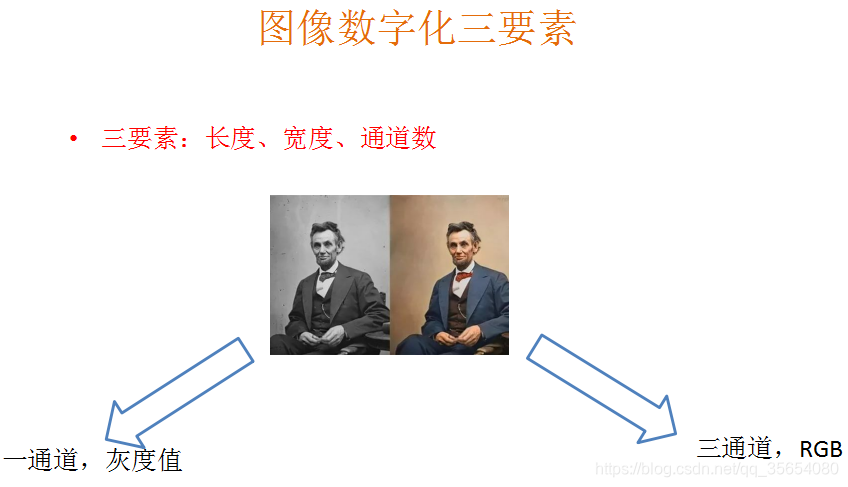
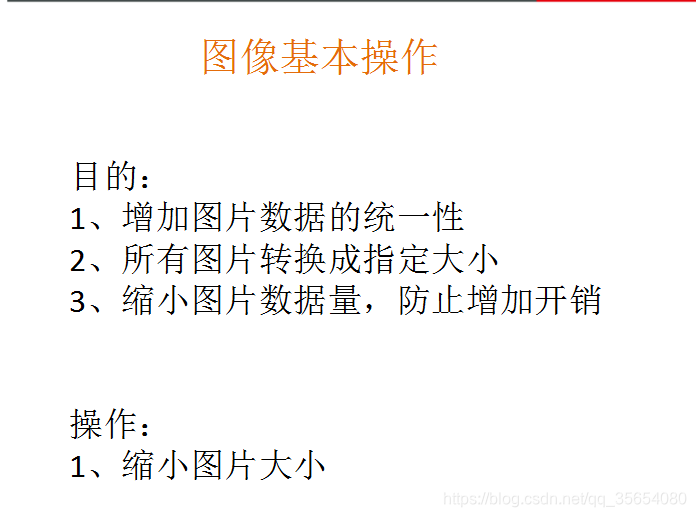
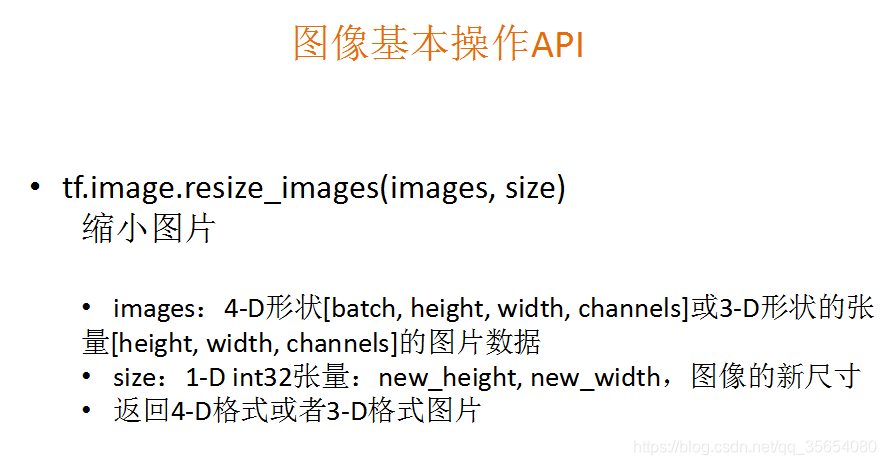
- tf.train.batch 读取指定大小(个数)的张量
- tf.train.shuffle_batch 乱序读取指定大小(个数)的张量


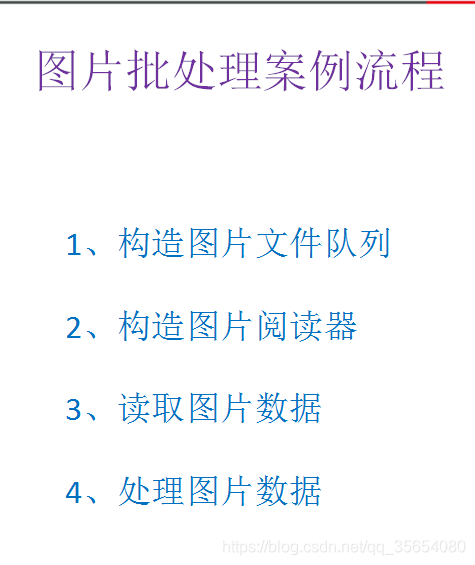
def picread(filelist):
"""
读取狗图片并转换成张量
:param filelist: 文件路径+名字的列表
:return: 每张图片的张量
"""
#1.构造文件队列
file_queue=tf.train.string_input_producer(filelist)
#2.构造阅读器去读取图片内容(默认读取一张图片)
reader=tf.WholeFileReader()
key,value=reader.read(file_queue)
print(value)
#3.对读取的图片数据进行解码
image=tf.image.decode_jpeg(value)
print(image)
#4.处理图片的大小(统一大小)
image_resize=tf.image.resize_images(image,[200,200])
print(image_resize)
image_resize.set_shape([200,200,3])
#6.进行批处理
image_batch=tf.train.batch([image_resize],batch_size=20,num_threads=1,capacity=20)
print(image_batch)
return image_batch
if __name__=='__main__':
file_name=os.listdir('./data/dog/')
filelist=[os.path.join('./data/dog/',file) for file in file_name ]
image_batch=picread(filelist)
with tf.Session() as sess:
coord=tf.train.Coordinator()
threads=tf.train.start_queue_runners(sess,coord=coord)
print(sess.run([image_batch]))
coord.request_stop()
coord.join(threads)
二进制读取
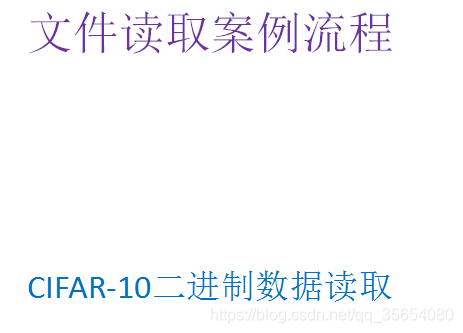
#定义cifar的数据等命令行参数
FLAGS=tf.app.flags.FLAGS
tf.app.flags.DEFINE_string('cifar_dir','./data/cifar-10-batches-bin/','文件的目录')
class CifarRead(object):
"""完成读取二进制文件,写进tfrecords,读取tfrecords"""
def __init__(self,filelist):
self.file_list=filelist
#定义读取的图片的一些属性
self.height=32
self.width=32
self.channel=3
#二进制每张图片的字节
self.label_bytes=1
self.image_bytes=self.height*self.width*self.channel
self.bytes=self.image_bytes+self.label_bytes
def read_and_decode(self):
#1.构造文件队列
file_queue=tf.train.string_input_producer(self.file_list)
#2.构造文件阅读器,读取内容,每个样本的字节数
reader=tf.FixedLengthRecordReader(self.bytes)
key,value=reader.read(file_queue)
#3.解码内容,二进制文件内容的解码
image_label=tf.decode_raw(value,tf.uint8)
#分割标签与图像张量,转换成相应格式
label=tf.cast(tf.slice(image_label,[0],[self.label_bytes]),tf.int32)
image=tf.slice(image_label,[self.label_bytes],[self.image_bytes])
print(image)
#给image设置形状
image_tensor=tf.reshape(image,[self.height,self.width,self.channel])
#print(image_tensor.eval())
#4处理流程
image_batch,label_batch=tf.train.batch([image_tensor,label],batch_size=1,capacity=1,num_threads=1)
return image_batch,label_batch
if __name__=="__main__":
# #1.找到文件,放入列表,路径+名字
# filename_list = os.listdir("./csvdata")
#
# readcsv_decode(filename_list)
#1.找到文件,放入列表,路径+名字
file_name=os.listdir(FLAGS.cifar_dir)
filelist=[os.path.join(FLAGS.cifar_dir,file) for file in file_name if file[0:4]=='data']
cfar=CifarRead(filelist)
image_batch,label_batch=cfar.read_and_decode()
with tf.Session() as sess:
#线程协调员
coord=tf.train.Coordinator()
#启动工作线程
threads=tf.train.start_queue_runners(sess,coord=coord)
#打印批处理的数据
print(sess.run([image_batch,label_batch]))
coord.request_stop()
coord.join(threads)
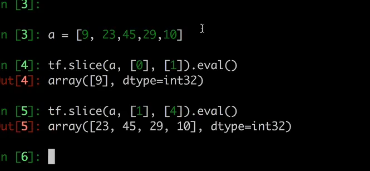
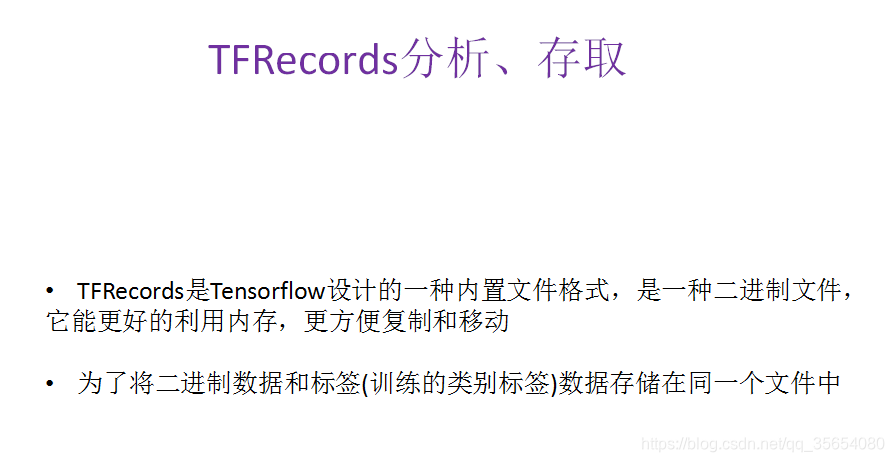
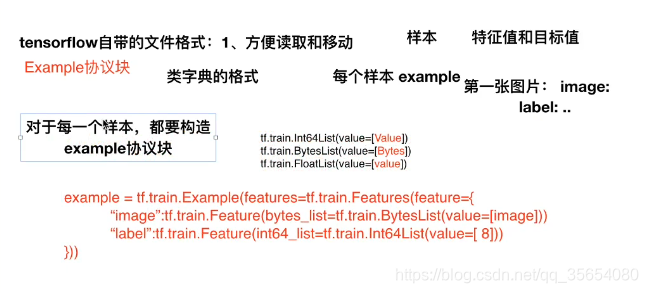
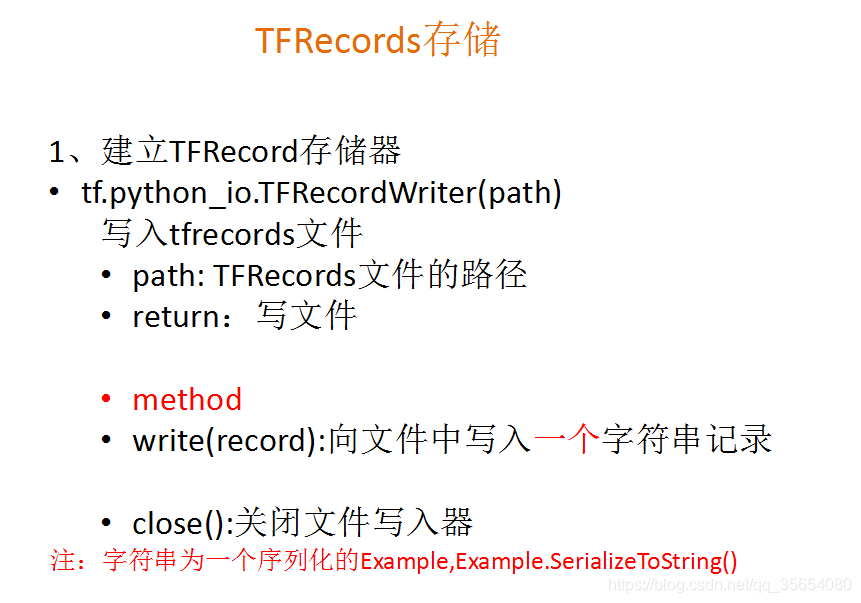
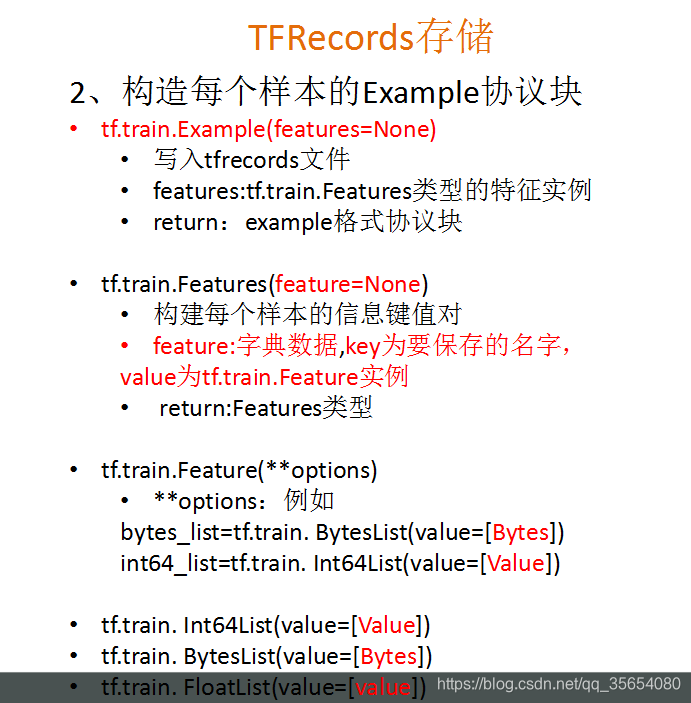


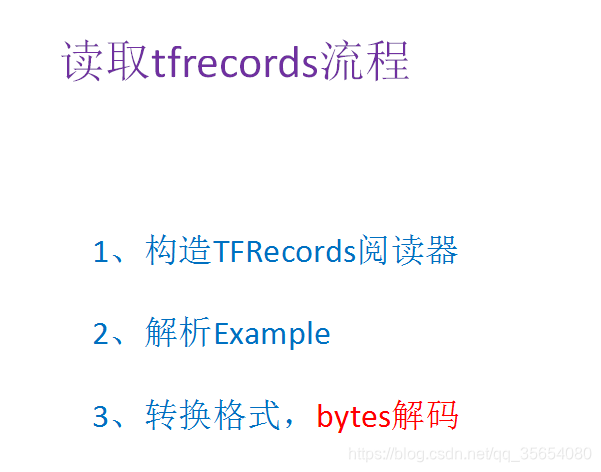
#定义cifar的数据等命令行参数
FLAGS=tf.app.flags.FLAGS
tf.app.flags.DEFINE_string('cifar_dir','./data/cifar-10-batches-bin/','文件的目录')
tf.app.flags.DEFINE_string("cifar_tfrecords", "./tem/cifar.tfrecords", "存进tfrecords的文件")
class CifarRead(object):
"""完成读取二进制文件,写进tfrecords,读取tfrecords"""
def __init__(self,filelist):
self.file_list=filelist
#定义读取的图片的一些属性
self.height=32
self.width=32
self.channel=3
#二进制每张图片的字节
self.label_bytes=1
self.image_bytes=self.height*self.width*self.channel
self.bytes=self.image_bytes+self.label_bytes
def read_and_decode(self):
#1.构造文件队列
file_queue=tf.train.string_input_producer(self.file_list)
#2.构造文件阅读器,读取内容,每个样本的字节数
reader=tf.FixedLengthRecordReader(self.bytes)
key,value=reader.read(file_queue)
#3.解码内容,二进制文件内容的解码
image_label=tf.decode_raw(value,tf.uint8)
#分割标签与图像张量,转换成相应格式
label=tf.cast(tf.slice(image_label,[0],[self.label_bytes]),tf.int32)
image=tf.slice(image_label,[self.label_bytes],[self.image_bytes])
print(image)
#给image设置形状
image_tensor=tf.reshape(image,[self.height,self.width,self.channel])
#print(image_tensor.eval())
#4处理流程
image_batch,label_batch=tf.train.batch([image_tensor,label],batch_size=10,capacity=10,num_threads=1)
return image_batch,label_batch
def write_ro_tfrecords(self, image_batch, label_batch):
"""
将图片的特征值和目标值存进tfrecords
:param image_batch: 10张图片的特征值
:param label_batch: 10张图片的目标值
:return: None
"""
# 1、建立TFRecord存储器
writer = tf.python_io.TFRecordWriter(FLAGS.cifar_tfrecords)
# 2、循环将所有样本写入文件,每张图片样本都要构造example协议
for i in range(10):
# 取出第i个图片数据的特征值和目标值
image = image_batch[i].eval().tostring()
label = int(label_batch[i].eval()[0])
# 构造一个样本的example
example = tf.train.Example(features=tf.train.Features(feature={
"image": tf.train.Feature(bytes_list=tf.train.BytesList(value=[image])),
"label": tf.train.Feature(int64_list=tf.train.Int64List(value=[label])),
}))
# 写入单独的样本
writer.write(example.SerializeToString())
# 关闭
writer.close()
return None
def read_from_tfrecords(self):
# 1、构造文件队列
file_queue = tf.train.string_input_producer([FLAGS.cifar_tfrecords])
# 2、构造文件阅读器,读取内容example,value=一个样本的序列化example
reader = tf.TFRecordReader()
key, value = reader.read(file_queue)
# 3、解析example
features = tf.parse_single_example(value, features={
"image": tf.FixedLenFeature([], tf.string),
"label": tf.FixedLenFeature([], tf.int64),
})
# 4、解码内容, 如果读取的内容格式是string需要解码, 如果是int64,float32不需要解码
image = tf.decode_raw(features["image"], tf.uint8)
# 固定图片的形状,方便与批处理
image_reshape = tf.reshape(image, [self.height, self.width, self.channel])
label = tf.cast(features["label"], tf.int32)
print(image_reshape, label)
# 进行批处理
image_batch, label_batch = tf.train.batch([image_reshape, label], batch_size=10, num_threads=1, capacity=10)
return image_batch, label_batch
if __name__=="__main__":
# #1.找到文件,放入列表,路径+名字
# filename_list = os.listdir("./csvdata")
#
# readcsv_decode(filename_list)
#1.找到文件,放入列表,路径+名字
file_name=os.listdir(FLAGS.cifar_dir)
filelist=[os.path.join(FLAGS.cifar_dir,file) for file in file_name if file[0:4]=='data']
cfar=CifarRead(filelist)
#image_batch,label_batch=cfar.read_and_decode()
image_batch,label_batch=cfar.read_from_tfrecords()
with tf.Session() as sess:
#线程协调员
coord=tf.train.Coordinator()
#启动工作线程
threads=tf.train.start_queue_runners(sess,coord=coord)
# # 存进tfrecords文件
# print("开始存储")
# #
# cfar.write_ro_tfrecords(image_batch, label_batch)
# #
# print("结束存储")
#打印批处理的数据
print(sess.run([image_batch,label_batch]))
coord.request_stop()
coord.join(threads)











 这篇博客介绍了TensorFlow中的图像操作,包括图像的基本概念,如图像的长宽和颜色通道,以及如何处理图像大小压缩。作者强调了预处理阶段进行图像操作的重要性,如缩小、裁剪等。还详细讲述了如何使用TensorFlow的函数读取和处理图像数据,包括解码JPEG图像、调整图像大小,并使用批处理和乱序读取提高效率。
这篇博客介绍了TensorFlow中的图像操作,包括图像的基本概念,如图像的长宽和颜色通道,以及如何处理图像大小压缩。作者强调了预处理阶段进行图像操作的重要性,如缩小、裁剪等。还详细讲述了如何使用TensorFlow的函数读取和处理图像数据,包括解码JPEG图像、调整图像大小,并使用批处理和乱序读取提高效率。
















 485
485

 被折叠的 条评论
为什么被折叠?
被折叠的 条评论
为什么被折叠?








